Maintenance worry as more fail tests
Page 5

If you've noticed an error in this article please click here to report it so we can fix it.
A HINT that the recession may be diminishing maintenance standards as well as leading to fewer vehicles on the road is contained in the latest statistics for goods vehicle tests.
According to the Department of Transport, 717,719 vehicles, including 203,696 trailers, were tested at the 91 Department of Transport heavy goods vehicle test stations in 1982/83, a one per cent fall compared with the 725,117 (202,624 trailers included) the previous year.
The number of vehicles being presented for tests has been declining since 1979, when the road transport industry reached an all-time peak of activity and 729,573 vehicles (including 204,420 trailers) were tested.
While the reduction in the number of vehicles is but a barometer of the economy and reflects the gradual reduction in activity as industry winds down, the increase in the failure rate suggests that maintenance standards are falling in some quarters.
This has risen to 20.2 per cent, which is the highest figure since 1979/80, and last year's failure rate for motor vehicles was 22.6 per cent, trailers being only 14.1 per cent.
The first test failure rate has been falling steadily since the scheme was started in 1970, and the failure rate was 33.1 per cent, and by 1981/82 was at an alltime-low of 18.8 per cent. It first fell below 20 per cent in 1980/81.
The failure rate for retests, by contrast, has fallen to its lowest rate since 1974/75. It is 8.3 per cent, having been 8.6 per cent in 1981/82 and 7.7 per cent in 1974/75.
The failure rate for all tests in 1982/83 was 18.1 per cent, against the previous year's 17.1 per cent all-time record low. It hovered around 19 per cent from 1974 to 1980 but fell from 30 per cent when the testing scheme first started.
Commenting on the figures, a Freight Transport Association spokesman said the industry should take note of any increase in the failure rate, however small. He said the FTA was disappointed that the trend had been reversed, and said that safety and operators' costs would be improved if they tightened up on their procedures.
The Road Haulage Association said it wanted to study the statistics in detail before making much comment, but suggested that an ageing vehicle population — the record intake of new vehicles in 1979 may have helped boost the improved figures then — may have led to some deterioration in test results.
























































































































